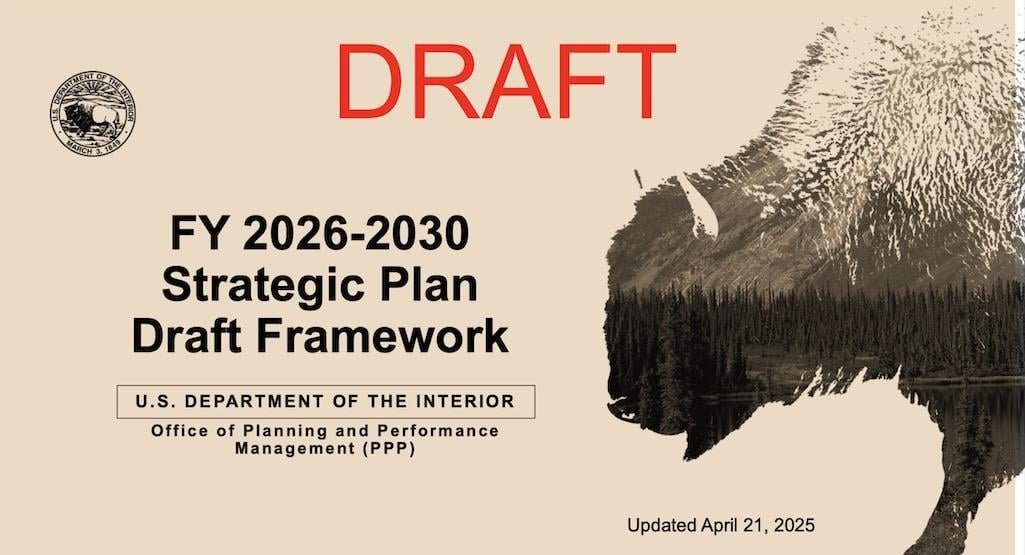
A draft Interior Department document calls for capitalizing on the country's natural resources through increasing use of them.
A draft copy of the Interior Department's 2026-2030 strategic plan calls for more public-private partnerships; increasing grazing, logging, and mining; improving management of trails; opening more lands to hunting and fishing, RV and snowmobile use; and restoring historic names to landmarks.
The 23-page internal, "pre-decisional" document (attached below) places consumption of the country's natural resources as the top priority to be reached through the lowering energy costs, "strategic use" of those resources, and using natural resources as assets going forward. Those goals could be accomplished through streamlined permitting, reduced costs for grazing and other consumptive land uses, and "strategic land swaps and exchanges."
The plan, leaked to Public Domain on Earth Day, was soundly criticized by Western Watersheds Project staff.
“Livestock grazing is already authorized at such heavy levels that it destroys native grasses, promotes the invasion of flammable weeds like cheatgrass, and outcompetes native wildlife like mule deer and elk for forage, radically reducing their numbers,” said Josh Osher, the group's policy director, on Wednesday. “The last thing the Department of Interior should be doing is pushing cattle and sheep into lands that have been protected from livestock for decades, where native perennial grasses are recovering and wildlife populations have been rebounding.”
The document's section calling for reducing the federal footprint to make way for local community housing and giving those communities more say in federal lands management also was panned by the organization.
"It is now widely recognized that state governments lack the staffing and infrastructure to manage federal public lands, so a large-scale transfer of public lands to state or county governments would amount to a sellout of public lands and a transfer to private ownership,” said Erik Molvar, Western Watersheds Project executive director. “All Americans have a strong interest in keeping public land in public hands, and allowing commercial and extractive uses only to the extent that they are compatible with maintaining healthy lands and abundant wildlife.”
Interior Secretary Doug Burgum earlier this month told his department's ~70,000 employees that unleashing the nation's energy resources is the answer to the country's long-term prosperity. In a video presentation he also said Interior has vast holdings across the country valued at roughly $100 trillion, and that the department should be generating at least $1 trillion in revenue annually for the government.
Part of getting there is making the department and its bureaus more efficient, the secretary said.
"When we cut red tape, we reduce a bunch of unnecessary work that is not helpful in terms of actually achieving the goals we have about protecting and managing the nation's national resources," Burgum said.
Osher feared the strategic plan would bring profits to "powerful local interests" at the expense of the American public that owns the lands.
“Every American has an equal stake in our western public lands, and they need to be managed for the public interest as a whole," he said. “For far too long, local governments have used inside influence to bend federal land management to suit their anti-environmental agendas, to kill wildlife, ramp up drilling, and overgraze the public lands. This new Strategic Plan directs agencies to put anti-conservation local and state governments in charge of public lands.”
The draft plan also lists as goals:
- A reduction in invasive species on public lands;
- More threatened and endangered species recovered to the point where they can be delisted from the Endangered Species Act;
- Better mapping and science to help communities plan and prepare for environmental disasters;
- Addressing Interior's long list of deferred maintenance in part by removing "unnecessary assets;"
- Further staff reductions, and;
- Reducing the square footage of federal facilities by canceling leases.
The document did not list any historic names that should be returned to landmarks, but one that might be considered is restoring "Clingmans Dome" to the tallest peak in Great Smoky Mountains National Park that last fall was renamed "Kuwohi," a Cherokee name for the mountain.

 Support Essential Coverage of Essential Places
Support Essential Coverage of Essential Places






